GE Profile UltraFast vs. LG WashCombo vs. Samsung Bespoke AI Combo Washers & Dryers
October 21st, 2025 | 7 min. read
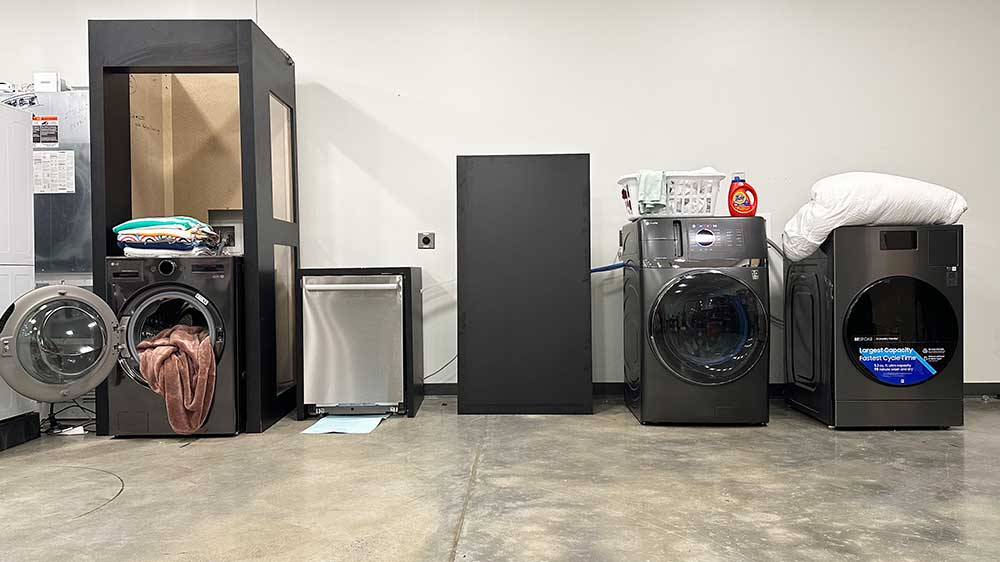
TL;DR: GE Profile vs LG vs Samsung: Best Combo Washer-Dryers
Modern heat-pump combos do work. LG WM6998HBA is fastest for daily laundry; GE PFQ97HSPVDS fits tight spaces and handles bedding best. Clean the filter after every cycle; large households are better with separate machines.
You’re probably wondering the same thing we hear every week in our showrooms: “Do these all-in-one washer-dryer combos actually work?”
For years, the honest answer was no. Older models couldn’t remove lint effectively, maintenance was a hassle, and drying cycles dragged on.
But 2025 is different.
Heat-pump technology, smarter sensors, and better filter designs have changed the game.
GE Profile and LG now make combos you can actually live with.
And while we don’t sell or service Samsung, we bought a brand-new unit to test side by side so you can see how it compares.
So, do they work?
In this guide, you’ll learn:
- How GE Profile, LG, and (for context) Samsung performed on identical test loads.
- Why upkeep and filter care matter more than spec sheets.
- What reliability looks like from 33,000+ Yale service calls last year.
- Who each machine is really for, and who should stick with a separate washer and dryer.
📽️ Prefer a Video?
Watch the video below for a quick look at how LG, Samsung, and GE Profile combo washer-dryers handle bedding, mixed colors, and whites.
We also cover reliability insights and when a traditional washer and dryer may be a better fit for larger households.
📌 Skip Ahead:
- Combo Washer-Dryers Before 2023
- How Do the New Combos Work
- Benefits of a Combo Washer-Dryer
- Downsides of a Combo Washer-Dryer
- Size & Fit: Specs at a Glance
- Performance (Real Test Results)
- Reliability (Yale Appliance Service Data)
- Who Are These Actually Good For?
Combo Washer-Dryers Before 2023
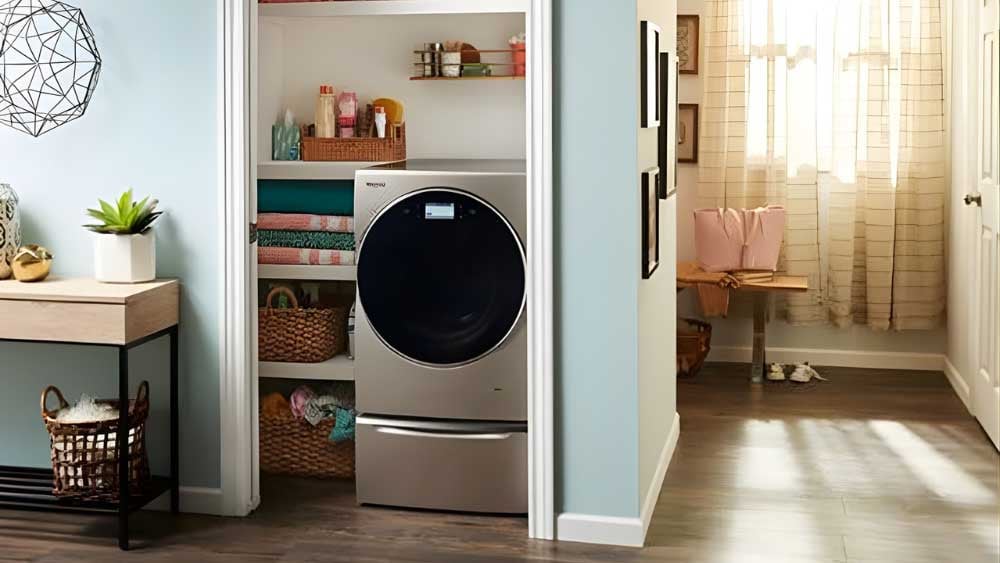
If you bought a combo before 2023, you were probably frustrated:
- Lint traps were inaccessible. You couldn’t clean them, and over time lint buildup could seize the machine.
- Drying was painfully slow. Heavy loads like bedding or towels almost always came out damp.
- Maintenance was constant. One machine trying to do two jobs meant more breakdowns and service calls.
That’s why for years we never recommended them in Boston brownstones, Cape rentals, or really anywhere else.
How Do the New Combos Work?
All three machines, GE Profile, LG, and Samsung, work on the same principle: a heat-pump dryer built into a front-load washer.

Think of it as the opposite of your refrigerator. In a fridge, the compressor and evaporator pull heat out to keep food cold.
In a combo, the compressor and heat exchanger push warm air in, then pull out the moisture and drain it away.

Because they’re ventless, you don’t lose heated air to the outside as with a traditional dryer. The air is recycled, making the system more efficient and gentler on fabrics.
Benefits of a Combo Washer-Dryer
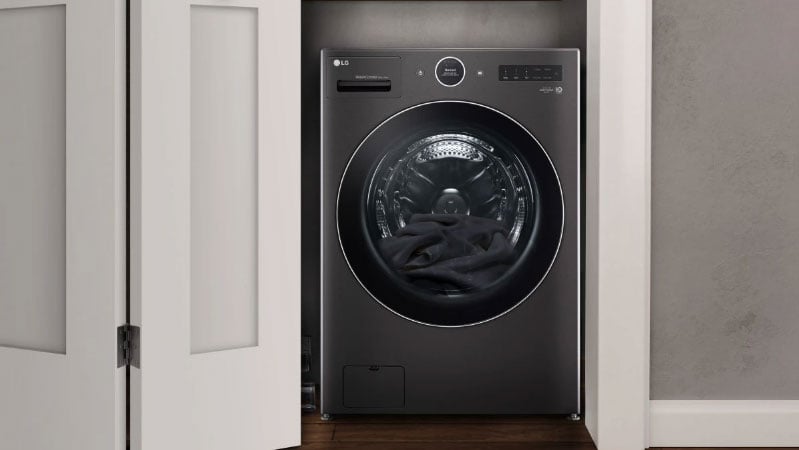
- 110-volt design. Built for standard outlets. Older 110-volt dryers couldn’t dry; these can.
- Ventless freedom. Any room with water and a drain can become a laundry room.
- True wash-to-dry convenience. Load dirty clothes, press start, and return to a finished load. Ideal if you start laundry before bed or before work.
- For tight spaces, rentals, or city homes without 240 volts or venting, these machines are absolutely worth considering.
Downsides of a Combo Washer-Dryer
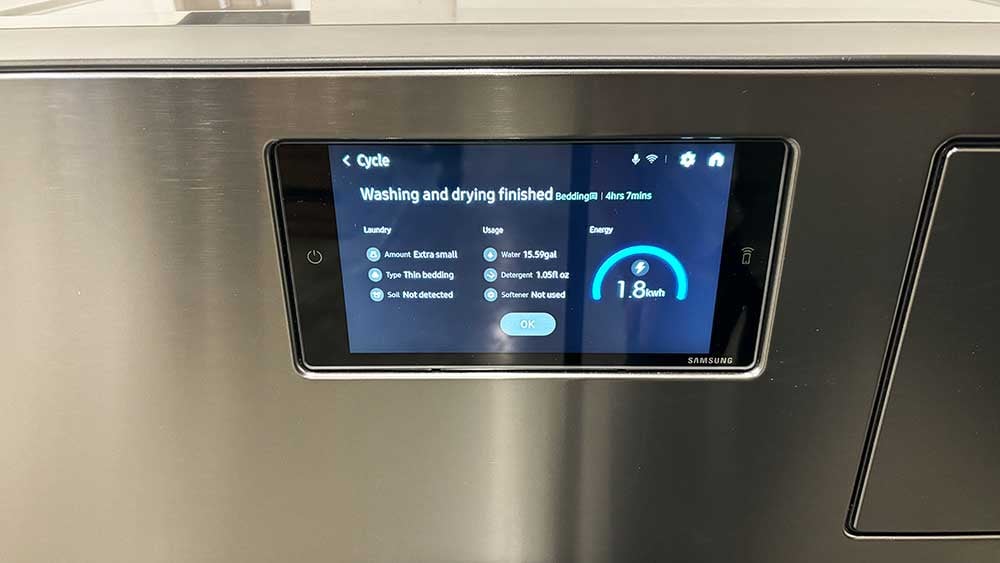
- Longer cycles. Expect about twice the time (or more) compared to a separate washer and dryer.
- Filter upkeep is critical. You must clean it after every cycle. Skip it, and you’ll face the same problems as older combos.
- Service is more complicated. These are closer to a refrigerator with a drum attached. Before buying, confirm who can service it in your area.
🛠️Maintenance tip: If dry times creep up, clean the primary filter and the condenser screen (LG includes one). A 60-second filter routine keeps performance steady.
Size & Fit: Specs at a Glance
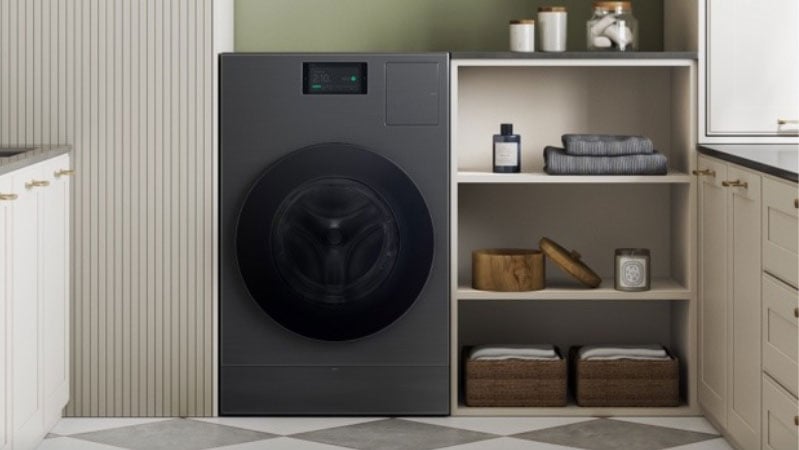
Before you fall in love with features, make sure it fits.
Here’s how LG, GE, and Samsung compare on capacity and footprint. Pay attention to depth, including real world clearance.
| Capacity | Width | Depth | Height | Notables | |
| LG WM6998HBA | 5.0 cu. ft. | 27" | 33.1" (~37" with clearance) | 39" | ezLintFilter top lift, included condenser screen, strong auto dose |
| GE PFQ97HSPVDS | 4.8 cu. ft. | 28" | 32" (flush) | 46.7" | Flush-fit depth, Microban surfaces, timed dry selectable at start |
| Samsung WD53DBA900HZA1 | 5.3 cu. ft. | 27" | 34.4" (~36.4" with clearance) | 43.7" | Largest drum, touchscreen, felt laggy, long bedding cycles |
Note: Depth values reflect practical clearance where noted. Always measure your doorway and path to the laundry space.
Fit Takeaways
- The cubic footage is similar across all three, but depth is the real issue. LG and Samsung both approach 37″ once you account for clearance.
- GE is the easiest option in tight installs because it sits flush at 32″.
👉 Tight space? Cape condo? Boston brownstone? Download our 2025 Washer & Dryer Buying Guide for real-life fit diagrams and install tips.
Performance (Real Test Results)
| LG WM6998HBA | GE PFQ97HSPVDS | Samsung WD53DBA900HZA1 | |
| Mixed Colors | 2 hours 17 minutes (Fully dried) | 2 hours 51 minutes (Fully dried) | 2 hours 29 minutes (Full Dried) |
| Whites | 3 hours 8 minutes (Fully Dried) | 2 hours 48 minutes (Fully Dried) | 2 hours 54 minutes (Fully Dried) |
| Sheets & Blankets | 3 hours 29 minutes (Mostly Dry) | 2 hours 8 minutes (Mostly Dry) | 6 hours 10 minutes (Mostly Dry) |
| Comforter | 2 hours 32 minutes (Mostly Dry) | 2 hours 1 minute (Mostly Dry) | 5 hours 26 minutes (Mostly Dry) |
| User Experience Notes | Short cycles, quiet, minimal lint | Software update required on first unit, effective post-update | Very long bedding cycles; difficult to make selections without pressing hard on the unit |
- Testing notes: Our first GE floor model shipped with outdated software and didn’t heat; a tech update resolved it. We repeated all GE tests on a new unit after updating. Findings above reflect the updated unit.
Performance Takeaways
- Cycle times for clothes are similar, but bedding differs significantly: GE 2 hr 08 min vs Samsung 6 hr 10 min.
- LG is fastest on everyday laundry.
- GE is best at bulky bedding (after a software update; confirm your unit is current).
- Samsung is the slowest overall, especially on bedding.
Performance Summary (Our Lab Notes)
LG WM6998HBA Performance Summary



- Fully dried lighter loads (sheets, whites, towels) and ran quietly with minimal lint.
- Comforters and heavy blankets sometimes needed extra drying. Shortest cycles overall.
GE Profile PFQ97HSPVDS Performance Summary


- Our initial floor model didn’t heat; a software update fixed it, and we retested on a new unit.
- Post-update, GE handled sheets, towels, and blankets well. Comforters were “mostly dry,” but we did see more lint than LG.
Samsung WD53DBA900HZA1 Performance Summary


- Consistently the longest cycles, especially for bedding.
- Comforters/blankets often finished slightly damp, even after 4+ hours. Towels dried fully. Touchscreen felt laggy and frustrating.
What this means for you:
- Fast daily loads → LG.
- Frequent bedding → GE (post-update).
- Time-sensitive homes should skip Samsung.
User Experience & Upkeep (From Testing)
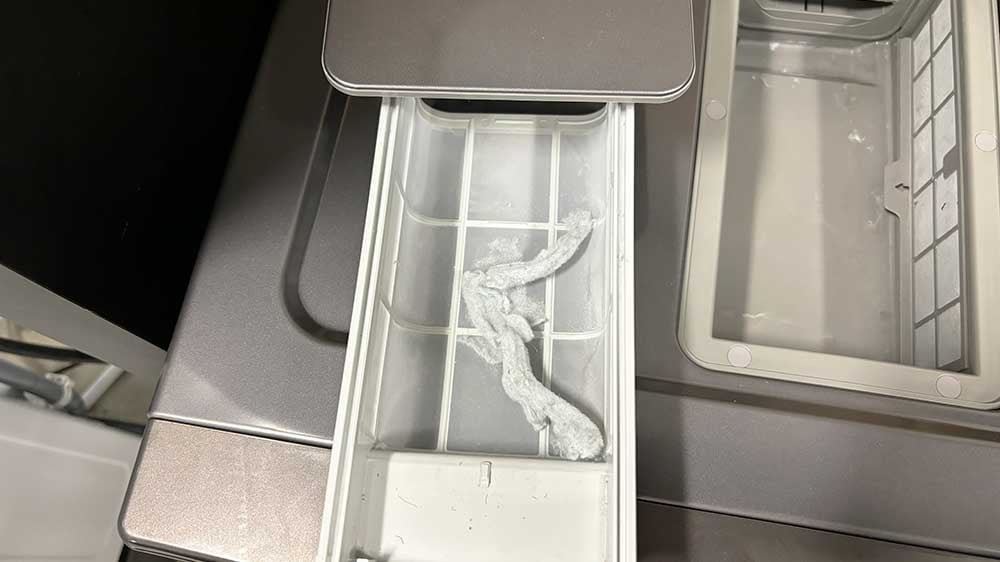
- Cycle feel: LG was the smoothest day-to-day; GE settled in once updated; Samsung’s touchscreen slowed basic tasks.
- Lint reality: LG produced minimal lint; GE produced more lint on some items—clean the filter after every cycle to keep dry times consistent.
- Heavy items: All combos left slight damp spots on comforters/blankets at times. Splitting loads or a short timed-dry pass usually finished them.
Reliability (Yale Appliance Service Data)
| First-Year Service Rate | Notes | |
| LG WM6998HBA | 4.1% | Easiest maintenance, reliable drying |
| GE PFQ97HSPVDS | 5.2% | Needed software update |
Why this is surprising:
- The average first-year service rate across all appliances is 9.5%.
- These combos, washer and dryer in one, came in well below that.
They are nearly identical to the rate of a normal front-load washer.
How we measure it: we divide the number of service calls within the first year by the number of units sold.
Samsung not included, as Yale does not sell or service Samsung combos.
🔍Read more: Are Combo Washers and Dryers Reliable?
👉 Reliability surprises many people. Download our 2025 Washer & Dryer Buying Guide for brand-by-brand service data from 33,000+ service calls.
Who Are These Actually Good For?
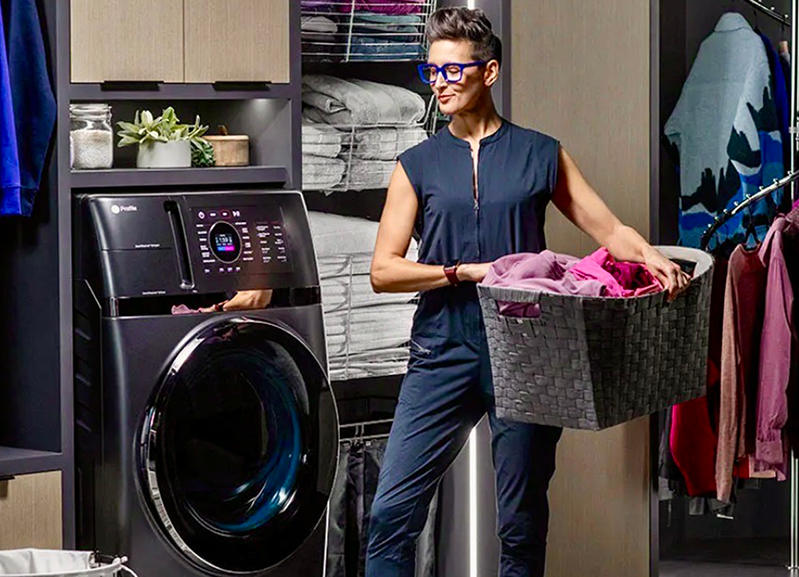
If you live in a Boston brownstone, a Cape rental, or anywhere without a 240-volt outlet or venting, a combo can be a game changer.
- Just plug it into a standard outlet, connect water and a drain, and you’re set.
- If you wash bedding every week, the GE PFQ97 is the fastest and flattest fit.
- It handles bulky loads better than the others, and its 32″ depth makes it the best bet for tight installs.
- If you want the best daily driver for clothes, towels, and kids’ laundry, LG is your winner. It’s fast, efficient, and its ezLintFilter makes upkeep less of a chore.
- If you run back-to-back loads or laundry for a big family, skip the combo. You’ll cut your laundry time in half with a traditional separate washer and dryer.
One thing to know no matter which you pick: these machines work only if you clean the filter after every cycle. That’s the new normal with heat-pump combos.
Who Should Buy What?
| Recommended Model | |
| You run weekly bedding/comforters | GE PFQ97HSPVDS |
| You want fast, low-friction daily laundry | LG WM6998HBA |
| You are patient and want more cycles and options | Samsung WD53DBA900HZA1 |
Quick Comparison (1-Minute Read)
Drying performance: LG and updated GE handled light/medium loads well. Comforters were the toughest across all three; Samsung struggled most.
Cycle time: LG shortest overall → GE → Samsung (often 4+ hours).
User Experience: LG smooth/simple; GE fine post-update but produced more lint on some loads; Samsung’s touchscreen was laggy.
Bottom line:
- Fast daily loads → LG
- Frequent bedding → GE (updated)
- Extra time/patience → Samsung
👉 Not sure if a combo will work for your laundry room? Give us a call, and we’ll help you figure it out before you buy the wrong thing.
FAQs
Answers to the most frequently asked questions about combo washers and dryers.
Do these combos run on a standard outlet?
Yes. GE and LG combos run on 120 volts.
Which one is actually fastest from wash to dry?
GE was fastest on bulky loads; LG was quickest on everyday laundry.
Can a combo really handle a king comforter?
Yes, but expect “mostly dry” on the first pass. Splitting loads works best.
Why do comforters finish “mostly dry”?
Heat-pump systems are gentler and recirculate air. Dense, multi-layer items trap moisture. Split the load or run a short timed-dry pass to finish.
Do combo washer-dryers need venting?
No. They are ventless. All you need is water, a drain, and a standard outlet.
How much maintenance do they need?
A lot. You must clean the lint filter after every cycle. Skip it, and you’ll run into the same problems as older combos.
How reliable are they compared to regular washers and dryers?
Surprisingly close. LG at 4.1% and GE at 5.2% are nearly the same as a stand-alone washer.
Which made the most lint?
LG produced minimal lint in our tests. GE produced more on some loads. Clean the filter after every cycle for best results.
Why did GE need a software update?
Our first unit shipped with outdated software and the heater did not engage. We updated the software through the SmartHQ phone app, then retested a new unit. Performance improved and the results in this review reflect the updated unit.
Additional Resources
Download our Yale Washer and Dryer Buying Guide with all the features, terms, and brands of laundry. Over 1 million people have already found answers in a Yale guide.
Related Articles:
- Are Combo Washers and Dryers Reliable?
- GE Profile vs. LG vs. Samsung Combo Washers and Dryers
- GE Profile UltraFast Combo Washer and Dryer: 2024 Review
- Should You Buy the LG WashCombo All-in-One WM6998HBA?
- Samsung Bespoke AI Combo Washer-Dryer WD53DBA900HZA1: 2024 Review
Recent Posts
Why Should You Trust Us?
It seems that every appliance review has nothing but glowing comments about almost every product, yet you read customer reviews and they are almost universally bad.
We are here to fill in the disconnect. We'll give you the best features, and the drawbacks as well, including reliability based on over 37,000 calls performed by our service team just last year. Our goal is to give you ALL the information so you know what's right for you.
Please consider subscribing or adding to the conversation in the comments below. We appreciate you stopping by.
Steve Sheinkopf is the third-generation CEO of Yale Appliance and a lifelong Bostonian. He has over 38 years of experience in the appliance industry, and he is a trusted source of information for consumers on how to buy and repair appliances.
Steve has also been featured in numerous publications, including the
New York Times,
Consumer Reports,
The Boston Globe,
Bloomberg Radio, the
New York Post,
The Wall Street Journal, and
Entrepreneur, for his knowledge of how to buy appliances and appliance repair.
Steve is passionate about helping consumers find the best appliances for their needs, and he is always happy to answer questions and provide advice. He is a valuable resource for consumers who are looking for information on appliance buying, repair, and maintenance.
Despite being the worst goalie in history, Steve is a fan of the Bruins and college hockey, loves to read, and is a Peloton biker. The love of his life is his daughter, Sophie.
A Note About Pricing
Pricing on this blog is for reference only and may include time sensitive rebates. We make every attempt to provide accurate pricing at time of publishing. Please call the stores for most accurate price.
Topics:

